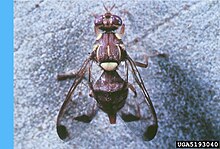കായീച്ച
ടെഫ്രിറ്റിഡേ കുടുംബത്തിൽ പെട്ട ഒരു തരം പഴയീച്ചയാണ് കായീച്ച (ബാക്ട്രോസെറ കുക്യുർബിറ്റേ). ഇത് കൃഷിനാശമുണ്ടാക്കുന്ന ഒരു കീടമാണ്.
| കായീച്ച | |
|---|---|

| |
| ശാസ്ത്രീയ വർഗ്ഗീകരണം | |
| കിങ്ഡം: | |
| Phylum: | |
| Class: | |
| Order: | |
| Section: | |
| Family: | |
| Genus: | |
| Species: | ബാക്ട്രോസെറ കുക്യുർബിറ്റേ
|
| Binomial name | |
| ബാക്ട്രോസെറ കുക്യുർബിറ്റേ (കോക്വില്ലെറ്റ്, 1849)
| |
| Synonyms | |
|
കൈറ്റോഡാക്റ്റസ് കുക്യുർബിറ്റേ | |
നിയന്ത്രണം
തിരുത്തുകരാസവസ്തുക്കളുപയോഗിക്കാതെയുള്ള നിയന്ത്രണം
തിരുത്തുകമെക്കാനിക്കൽ
തിരുത്തുകപഴങ്ങൾ വളരുന്ന സമയത്ത് സംരക്ഷണത്തിനായി ഒരു കവർ കൊണ്ട് മൂടുക. കെണികളൊരുക്കുന്നതും ഇത്തരം നിയന്ത്രണമാർഗ്ഗത്തിൽ പെടുന്നു.
പരമ്പരാഗതമാർഗ്ഗം
തിരുത്തുകകീടബാധയുണ്ടായതും വിൽക്കാൻ സാധിക്കാത്തതുമായ എല്ലാ പഴങ്ങളും നശിപ്പിക്കുകയും വിളവെടുപ്പ് കഴിഞ്ഞാൽ വിളയുടെ ശേഷിപ്പുകൾ നിശ്ശേഷം നശിപ്പിക്കുകയും ചെയ്യുക.
ജൈവനിയന്ത്രണം
തിരുത്തുക1947-നും 1952-നുമിടയിൽ കായീച്ചകളുടെ മുപ്പത്തിരണ്ടുതരം സ്വാഭാവിക ശത്രുജീവികളെ ഹവായിയിൽ എത്തിക്കുകയുണ്ടായി. ഇത്തരം പരാദജീവികൾ കായീച്ചകളുടെ മുട്ടകളിലോ പുഴുക്കളിലോ മുട്ടയിടുകയും പ്യൂപ്പ അവസ്ഥയിൽ ഇവ വിരിയുകയുമാണ് ചെയ്യുന്നത്.
ഫോപ്പിയസ് അരിസാനസ്, പൈസ്റ്റാലിയ ഫ്ലെറ്റ്ചേരി എന്നീ തരം ബ്രാക്കോനിഡ് പരാദജീവികളെ ഉപയോഗിക്കുമ്പോൾ (ഇവ കായീച്ചകളുടെ മുട്ടകളെയും ലാർവകളെയും ഒരേസമയം നശിപ്പിക്കാൻ ശേഷിയുള്ളവയാണ്) 56% വരെ കീടശല്യം കുറയുകയുണ്ടായി.[1]
റേഡിയേഷൻ
തിരുത്തുകആൺ കായീച്ചകളെ ഇറേഡിയേഷൻ വഴി വന്ധ്യംകരിക്കുന്നത് ഫലപ്രദമായി കണ്ടിട്ടുണ്ട്.[2]
രാസനിയന്ത്രണം
തിരുത്തുകകീടനാശിനികളിൽ കായീച്ചകളെ ആകർഷിക്കുന്ന പ്രോട്ടീൻ ദ്രാവകങ്ങൾ കലർത്തി തളിക്കുന്നത് നിയന്ത്രണത്തിനുള്ള ഫലപ്രദമായ മാർഗ്ഗമാണ്.
അവലംബം
തിരുത്തുക- ↑ "ARS | Publication request: Parasitization of Melon Fly (Diptera:tephritidae) by Fopius Arisanus and Psyttalia Fletcheri (Hymenoptera:braconidae) and the Effect of Fruit Substrates on Host Preference by Parasitoids". Ars.usda.gov. Retrieved 2010-07-30.
- ↑ http://www.scialert.net/qredirect.php?doi=pjbs.2006.2478.2482&linkid=pdf
കൂടുതൽ വായനയ്ക്ക്
തിരുത്തുക- Agarwal, M. L., D. D. Sharma and O. Rahman. 1987. Melon Fruit-Fly and Its Control. Indian Horticulture. 32(3): 10-11.
- Bess, H. A., R. van den Bosch and F. H. Haramoto. 1961. Fruit Fly Parasites and Their Activities in Hawaii. Proc. Hawaiian Entomol. Soc. 27(3): 367-378.
- Heppner, J. B. 1989. Larvae of Fruit Flies. V. Dacus cucurbitae (Melon Fly) (Diptera: Tephritidae). Fla. Dept. Agric. & Consumer Services, Division of Plant Industry. Entomology Circular No. 315. 2 pages.
- Hill, D. S. 1983. Dacus cucurbitae Coq. pp. 391. In Agricultural Insect Pests of the Tropics and Their Control, 2nd Edition. Cambridge University Press. 746 pages.
- Lall, B. S. 1975. Studies on the Biology and Control of Fruit Fly, Dacus cucurbitae COQ. Pesticides. 9(10): 31-36.
- Liquido, N. J., R. T. Cunningham, and H. M. Couey. 1989. Infestation Rate of Papaya by Fruit Flies (Diptera: Tephritidae) in Relation to the Degree of Fruit Ripeness. J. Econ. Ent. 82(10): 213-219.
- Lockwood, S. 1957. Melon Fly, Dacus cucurbitae. Loose-Leaf Manual of Insect Control. California Department of Agriculture.
- Marsden, D. A. 1979. Insect Pest Series, No. 9. Melon Fly, Oriental Fruit Fly, Mediterranean Fruit Fly. University of Hawaii, Cooperative Extension Service, College of Tropical Agriculture & Human Resources.
- Nishida, T and H. A. Bess. 1957. Studies on the Ecology and Control of the Melon Fly Dacus (Strumeta) cucurbitae Coquillett (Diptera: Tephritidae). Hawaii Agric. Exp. Station Tech. Bull. No. 34. pages 2–44.
- Nishida, T. and F. Haramoto. 1953. Immunity of Dacus cucurbitae to Attack by Certain Parasites of Dacus dorsalis. J. Econ. Ent. 46(1): 61-64.
- Vargas, R. I. and J. R. Carey. 1990. Comparative Survival and Demographic Statistics for Wild Oriental fruit Fly, Mediterranean Fruit Fly, and Melon Fly (Diptera: Tephritidae) on Papaya. J. Econ. Ent. 83(4): 1344-1349.
- Anonymous. 1959. Insects not known to occur in the United States. Cooperative Economic Insect Report 9 (19): 343-368. Melon fly (Dacus cucurbitae (Coq.)),: 367-368.
- Back EA, Pemberton CE. 1917. The melon fly in Hawaii. U.S. Department of Agriculture Bulletin 491: 1-64.
- Bautista R, Harris E, Vargas R, Jang E. (2004). Parasitization of melon fly (Diptera: Tephritidae) by Fopius arisanus and Psyttalia fletcheri (Hymenoptera: Braconidae) and the effect of fruit substrates on host preference by parasitoids. ARS-Research. http://www.ars.usda.gov/research/publications/Publications.htm?seq_no_115=155470 (26 July 2004).
- Berg GH. 1979. Pictorial key to fruit fly larvae of the family Tephritidae. San Salvador: Organ. Internac. Reg. Sanidad. Agropec. 36 p.
- Chu HF. 1949. A classification of some larvae and puparia of the Tephritidae (Diptera). Cont. Inst. Zool., Natl. Acad. Peiping (Beijing) 5: 93-138
- Green CT. 1929. Characters of the larvae and pupae of certain fruit flies. Journal of Agricultural Research (Washington) 38: 489-504.
- Hardy DE. 1949. Studies in Hawaiian fruit flies (Diptera, Tephritidae). Proceedings of the Entomological Society of Washington 51: 181-205.
- Heppner JB. 1988. Larvae of fruit flies IV. Dacus dorsalis (Oriental fruit fly) (Diptera: Tephritidae). Florida Department of Agriculture and Consumer Services, Division of Plant Industry Entomology Circular 303: 1-2.
- Foote RK, Blanc FL. 1963. The fruit flies or Tephritidae of California. Bulletin of the California Insect Survey 7: 1-117.
- Phillips VT. 1946. The biology and identification of trypetid larvae (Diptera: Trypetidae). Memoirs of the American Entomological Society 12: 1-161.
- Pruitt JH. 1953. Identification of fruit fly larvae frequently intercepted at ports of entry of the United States. University of Florida (Gainesville), MS thesis. 69 p.
- USDA, Survey and Detection Operations, Plant Pest Control Division, Agriculture Research Service. Anonymous. 1963. The melon fly. Pamphlet 581. 4 p.
- White IM, Elson-Harris MM. 1994. Fruit Flies of Economic Significance: Their Identification and Bionomics. CAB International. Oxon, UK. 601 p.